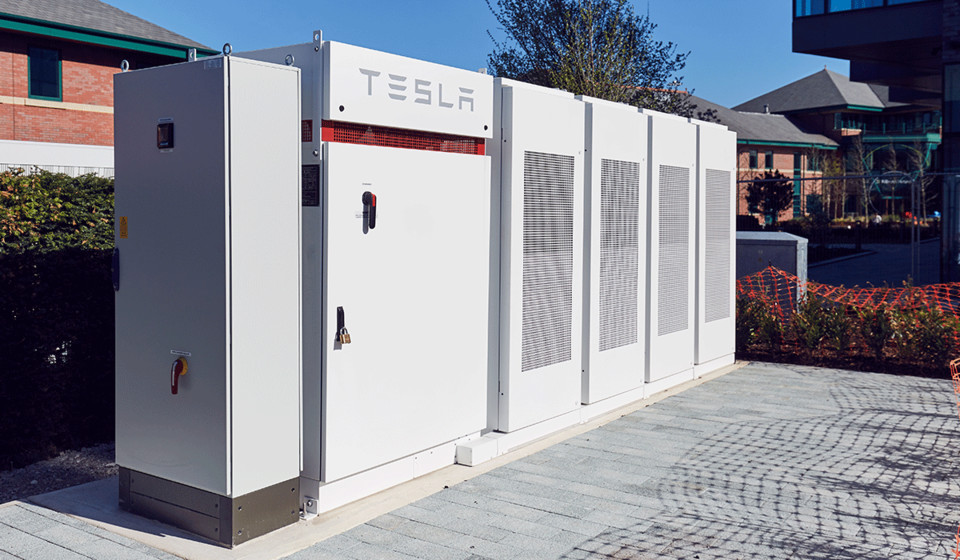MSP looks to the future with industry-leading advanced energy storage
By Bruntwood

The most advanced commercial energy storage solution currently available has been unveiled by Manchester Science Partnerships (MSP).
In a UK industry-leading move, the country’s leading science and technology park operator has invested more than £400,000 in its advanced energy strategy.
This investment includes the installation of a Tesla Powerpack system outside its flagship HQ, the Bright Building, at Manchester Science Park, along with two new charging points for electric vehicles.
The move will help insulate MSP from shifting commercial tariffs and escalating non-commodity prices, while also allowing it to substantially reduce its carbon footprint through wider use of renewable energy.
With buildings accounting for more than a third of total UK greenhouse gas emissions, this latest investment is further evidence of both MSP’s, and majority shareholder Bruntwood’s, commitment to operating sustainably and addressing the world’s environmental challenges head-on.
Crucially, the Tesla Powerpack also allows MSP to offer customers operating in R&D-heavy sectors unrivalled assurances in resilience and business continuity.
It can kick-in in less than a second should primary power fail – a marked improvement on previous industry norms of up to 30 minutes.
The Powerpack system at the Bright Building has been installed with four Powerpacks and one inverter. It is a flexible, scalable battery system, with, in this case, the ability to have up to sixteen additional Powerpacks added to it if the requirements for the building increase on a power and/or energy level.
This ability to expand, as future requirements and the energy markets change, provides another level of resilience and reassurance, with the potential for the building to run all day on its energy storage system, if required.
It will give MSP the future capability ability to store power from renewable sources – such as solar energy generated during the day – and distribute it efficiently and judiciously at peak times, reducing reliance on the National Grid.
Tom Renn, MSP managing director, said: “As the only UK science and technology park operator to be offering this kind of advanced energy innovation, it’s something we’re understandably very excited about. “MSP and Bruntwood are committed to investing in our buildings, utilising cutting-edge technology to both improve the experience of our customers and reduce our carbon footprint.
“This pilot installation marks a key milestone in our advanced energy strategy. It also makes good on a commitment to invest in sustainable improvements to our campuses, signed up to as part of our green funding package with Lloyds Bank.
“We have bold plans to harness the opportunities provided by advanced energy. We envisage that within 12 months, the Bright Building will be an energy island – self-sufficient and operating without reliance on the National Grid.”
Bev Taylor, Bruntwood’s Head of Energy, said: “The cost and feasibility of implementing lithium-ion batteries has changed markedly in recent years, making commercial energy storage viable. “We’ll be monitoring the cost savings and CO2 reduction in the coming months, with a view to installing further units at other Bruntwood buildings and developments, such as Circle Square, Alderley Park and Innovation Birmingham.”
The pioneering project has received grant funding from CityVerve – Innovate UK’s smart city demonstrator project in which MSP is a lead partner.
Earlier this year MSP agreed a three-year finance package with Lloyds Bank in line with the lender’s Commercial Real Estate’s Green Lending Initiative.
Under the terms of its loan, which is the first of its kind to be completed by the bank in the North West of England, MSP has agreed to a series of ‘green covenants’.
This includes committing to spend more than £600,000 investment in sustainable improvements to its existing campuses, reducing annual energy intensity of all its assets by 3.5 per cent a year and increasing the amount of energy its buildings use from renewable sources by a further 10 per cent.
Stay Connected!
Sign up to our newsletter for the latest news, updates and offers.